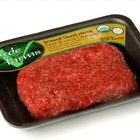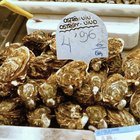
Bacteria found naturally on foods multiplies to dangerous levels when kept in unsafe temperatures. Refrigeration slows the growth of these bacterium, keeping the food safe to eat. A cooler functions the same as a refrigerator when the proper temperatures are maintained. Filled with ice, a cooler keeps even the most perishable foods safe to eat long after the picnic ends, right up to their expiration date if you are willing to monitor the inside temperature.
Temperature
Perishable foods stored in a cooler packed with ice remain safe to eat for their natural time span as long as the temperature inside remains below 40 degrees Fahrenheit. Once the temperature inside rises, the food is only edible for two hours. If the temperature inside the cooler tops 90 F, the food is only safe to eat for one hour. Place an appliance thermometer inside the cooler to monitor temperature, adding ice as needed to keep the temperatures below 40 F.
Pack It Right
Packing the cooler properly helps keep food safer longer. Transfer food items directly from the refrigerator to the cooler, packing them in the opposite order that you plan to use them. Pack foods in airtight, waterproof containers to protect the food from melting ice. When using a cooler for the transport of raw meats, freeze the meat first and place at the bottom of the cooler. Once packed, only open the cooler when necessary.
Fill It Up
To keep the cooler colder longer, fill it to the brim with ice. Any space between the food and the lid of the cooler makes maintaining a constant temperature below 40 F difficult. Fill all gaps in the cooler with ice or ice packs, but do not overfill -- the lid should close tightly. After packing, keep the cooler out of direct sunlight, covering it with an umbrella or towel if shade is not available.
Warning
A cooler should never be used for re-cooling purposes. Once foods have remained in temperatures above 40 F for two hours or 90 F for one hour, they are no longer safe to eat, let alone be placed back in the cooler. By this time, bacteria has grown to dangerous levels and the temperatures inside the cooler are not enough to keep the bacteria from multiplying. Throw these foods away to reduce your risk of serious food-borne illnesses.
Related Articles

Does Caviar Go Bad?
How to Keep Deli Meats & Fruit Cold at ...

How Long After Catching Should You Cook ...
Maximum Storage Temperature of Canned ...

How to Keep a Beer Keg Cold

Does a Chilled Champagne Bottle Need to ...

Rival Seal-a-Meal Vacuum Food Sealer ...
How to Keep Buffet Food Cool

Containers That Keep Food Hot

How to Keep Ice Cream Cold Enough for a ...

How to Cook With a Gas Fireplace

How to Freeze Ground Beef

The Best Method to Store Fresh Oysters

How Long Do Shucked Oysters Stay Fresh?

Proper Placement of Medals on a USMC ...

The Steps in Cooking Raw Foods in a ...

How to Freeze Bratwurst

How Long Can Cooked Salmon Last ...

How to Dehydrate Food With an Oven for ...

Can You Freeze Raw Oysters?
References
Writer Bio
Jonae Fredericks started writing in 2007. She also has a background as a licensed cosmetologist and certified skin-care specialist. Jonae Fredericks is a certified paraeducator, presently working in the public education system.
Photo Credits
Jupiterimages/liquidlibrary/Getty Images